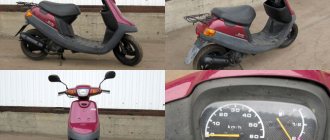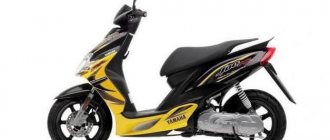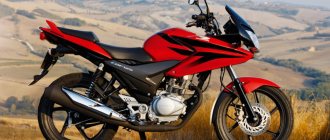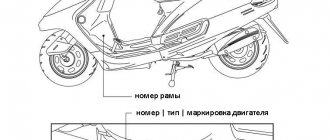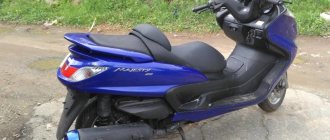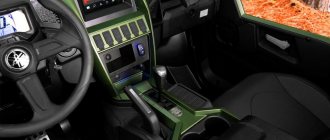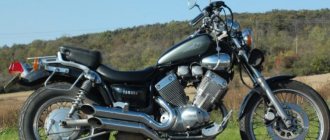Hello two-wheeled vehicle lovers!
I have long wanted to evaluate some kind of maxiscooter. Is this really a “sofa on wheels”? While on vacation in Adler, I was interested in renting a Yamaha Majesty 400. I drove almost 400 kilometers on it in two days. I drove along different roads: along mountain serpentine roads and in a straight line. And this is the impression I got about this car, I’ll tell you about the pros and cons, who it will suit, and who should not take it.
Specifications
Engine with a volume of 395 cm3 and a power of 34 hp. With. allows you not only to easily cope with long trips on country roads, but also with slow driving in traffic jams. The maximum speed of the Yamaha Majesty is 125 kilometers per hour. Gasoline consumption is 4.7 liters per 100 kilometers, tank volume is 14 liters, gearbox is CVT.
The scooter has a four-stroke single-cylinder engine with fuel injection system and liquid cooling. Thanks to fuel injection and four valves, the engine is economical and has a high environmental friendliness (low exhaust emissions). Like most scooters, torque is transmitted from the engine to the rear wheel through a CVT belt.
The characteristics of the Yamaha Majesty 400 include an excellent braking system, it is represented by double disc brakes with a diameter of 267 millimeters on the front wheel, and single disc brakes are installed on the rear wheel. The levers are adjustable, so you can set the brake sensitivity specifically for yourself. This allows you to make control as convenient as possible and get used to it as quickly as possible.
Yamaha Majesty 400 scooter review
The first thing that comes to mind is that in front of you is a small pleasure yacht, certainly very expensive and attractive. Let me immediately mention that with subsequent acquaintance, the initial feeling increases exceptionally. You understand in your brain that this is an example of a two-wheeled tribe, but your personal “I” does not perceive such a leveling of greatness. By the way, Majesty in translation means “majesty.” The Yamaha Majesty 400 scooter was completely invented, right down to the engine, from scratch. Impressive contours of the body with a huge front fairing and an equally huge front glass, an abyss of various luggage niches and glove compartments, a high “stern” with a wide “sofa”. It all tops off with a very large spoiler, a cluster of LED brake lights and a decent outlet pipe for a large-caliber muffler. It’s just that the “face” is very average.
For some reason, there is a belief that everything is OK under the plastic. I take my will into a fist and force myself to look under the body from below. Look, there is also an engine here :). Yes, not a simple engine, but a four-stroke “single-barrel” with a volume of 395 cm3 with 2 overhead camshafts, a fuel injection system and a vibration-reducing balance shaft with a power of 34 horsepower. The engine is coupled, as befits a scooter, with a CVT. And the assembly of the unit provides every reason to say that this is a motor scooter, albeit of a “royal scale”: 223 cm in length is a serious thing. We sit at the helm, turn the key in the lock, tidy up the footrest and squeeze the brake (you can’t start the engine any other way - it’s a scooter). Only after these manipulations does the engine come to life from the starter button. While the engine is warming up, we get acquainted with the “working area”, in which the Apehanger- (highly thrown out handles, like on BMW tourers), scooter controls get along well with a giant dashboard, probably borrowed from a small car. Speedometer, tachometer, daytime, overhaul, total mileage, engine temperature, fuel gauge, clock, the usual set of switches, plus a high beam “blanker” and... the handbrake handle (on a scooter!). Under the steering column there is a lockable car “glove compartment”, in which a raincoat and gloves can easily be located, and next to it - less, we can put a wallet and a mobile phone here (with such a reserve, wealthy people are allowed to go even around the world). It’s a shame that Yamaha doesn’t include a radio with this modification; there’s plenty of room for mounting it. Another 59 liter capacity (with light) is available under the seat. I don’t think a box of vodka will fit in it, but if you take the bottles out of the box, there’s still room for a snack.
The driving position of the unit is a typical chopper. You sit deeply, on a wide seat with back support, your arms are relaxed, your legs are extended forward. In terms of comfort, the Majesty's seating can be compared to that of a Honda GoldWing . We seat a friend with figures suitable for the class of scooter behind her. The ladies' quilts serve as elbows, and the bust (praise to the stepped saddle) serves as a headrest :). This elegant scooter cannot be called small-sized (base 1565 mm). You will inevitably register and gain a motorcycle category.
On the roadway, the unit behaves quietly, predictably and with certainly not motorcycle comfort. The injection engine has a typical “reflection” between the stroke of the throttle and the response of the drive wheel. Such impressiveness is compensated with sensational performance by excellent driving properties. The front suspension stays are as much as 41 mm in diameter, an absolutely sporty size. Auto wheels: front - 14, rear - 13 inches. The tires perform well on any surface, including in the rain. In the flow of cars, the scooter glides with a clearly visible advantage, while moving much faster than the flow. Having lined up behind a foreign car, you don’t even need to blink your headlights, they step aside, thinking that it’s a sportbike. Lounging in a comfortable chair, you can slowly drive along the highway for a long time, enjoying the roar of the oncoming air flow, which is facilitated by the unusually soft suspension and the unnaturally muffled liquid-cooled engine. And if you suddenly want to cheer up, just drive off the highway onto a winding path and add gas, giving the engine a chance to recall itself through the muffled noise. At the same time, the unit takes turns well, forgiving the driver, including gross mistakes in selecting the line of movement, and makes it possible to truly enjoy the process of moving. The acceleration dynamics, which are decent for a car, practically do not deteriorate when driving with a passenger, except that it “jokes around” on turns more strongly, after all, the mass of the passenger is located above the driver.
Maximum speed of Yamaha Majesty 400 is 125 km/h
Unlike its ancestor, the frame hardness of the Majesty 400 has increased significantly. According to official data from the manufacturer, thanks to the latest design of a combined frame made of duralumin alloy with built-in steel reinforcements in the lower part, torsional rigidity has increased by 86%, and enfilade stiffness, respectively, by 54% (compared to Majesty YP250 ). The brakes are absolutely adequate to the engine size, and most importantly - to the speed of the mechanism. The dosage of force is extremely precise and logical. With the intention, the strain of two fingers simply breaks the wheels into sliding, which is why the head is always obliged to watch the hands, yet ABS is not installed on the provided modification. The device feels “at ease” not only on suburban highways, but also in the center of a metropolis filled with cars. The agility, which is amazing for such a long car, makes it possible to gracefully pass near cars stuck in traffic jams and leave the main intersection, and the weightless wheels eat up virtually all kinds of potholes on the road.
In a downpour, the need for a raincoat is not too great, the huge front fairing protects very well from bad weather, the heavenly water is literally blown back by an unmistakably distributed oncoming air flow, keeping the driver dry, which cannot be said about the passenger (he sits very elevated).
The motor market for super sofas here, in Ukraine, is now not as popular as in other European settlements. It's a pity that the primitive human factor comes into play. From time to time, it is difficult for equipment dealers to convince the buyer of the need to purchase similar units, although for those who have operated equipment of a similar class, the benefits are undeniable. Majesty 400 is a superb poly-hybrid of the best features of a bike and a scooter. It has everything: the usual scooter ergonomics and protection from bad weather, skillful controllability, a powerful, torquey engine and a charming appearance. Anyone who tests the Majesty 400 will truly enjoy handling this horse.
Other indicators
The suspension is comfortable, with long strokes (rear 104 mm, front 120 mm), it perfectly copes with various uneven road surfaces not only in the city, but also on suburban routes. This is partly why reviews of the Yamaha Majesty 400 are so good: it is comfortable to travel even over long distances. The fork is telescopic and the rear has pendulum suspension.
The wheels for the scooter are very solid, the front diameter is 14 inches, and the rear is thirteen inches, this significantly affects the ride comfort, as it helps hide road irregularities and improves handling.
Test drive SuzukiSkyWave 400, YamahaMajesty 400
Killing two birds with one stone is a difficult task. But it’s even more difficult to kill three at once. In fact, that’s exactly what it turned out to be. For a whole week we tried to find and combine in one large comparative test the three most common representatives of the 400 cc scooter family - the Japanese Suzuki Burgman (Skywave), Yamaha Majesty and Honda Silver Wing. And when we were holding all three of us at gunpoint, the “gun” suddenly misfired and one of them, namely Silver Wing, managed to hide “behind the bushes”... and we never saw him again. Well, the remaining two are also good catch. In addition, both are aggressive enough to show each other their “teeth”, or at least measure the length of... exhaust pipes.
To adequately compare scooters, they need to be in approximately the same condition. We saw a slightly different picture. While outwardly both devices looked almost like new, their internal condition was still different. Our experimental Yamaha Majesty 400 was released in 2006, and the Suzuki Skywave has covered tens of thousands of kilometers since 2003. Skywave's long career was taking its toll, and it was felt that if he had been younger, he could have performed much better. But, looking ahead, I will say that in all respects he did not perform much worse than his opponent.
In 2003, Suzuki completely redesigned the scooter and introduced a lot of innovations into it. Since 2003, the Skywave 400 has been equipped with a fuel injection system and a combined braking system. The Yamaha Majesty 400 first came out in 2004 and hasn't changed much since then, so if we were to test the 2007 Skywave, the balance might not be in Yamaha's favor.
It is worth saying that when creating its scooter, Yamaha took into account all the shortcomings of its main competitor, and therefore, sitting behind the wheel of the Majesty, you feel very cozy and comfortable. All major controls are within easy reach. Even to put the handbrake on the scooter, you don’t need to reach anywhere. The necessary lever is activated by the thumb of the left hand, which at this time continues to rest on the steering wheel. The seat not only supports, but actually envelops the driver’s butt and lower back. The angle at which the driver's backrest is located is adjusted to the nearest degree, and therefore in the Majesty seat you can drive hundreds of kilometers in a row without fatigue. Platforms for the legs allow you to either comfortably place them in a half-bent position or extend them forward. In addition, there is an alternative, intermediate position.
After the Majesty, the Skywave's driver's seat does not seem so comfortable. Trying to figure out what was what, I discovered that the first inconvenience lies in the shape of the steering wheel. The ends of its handles are too bent towards the driver, and therefore the hands feel slight discomfort, which disappears only after several kilometers spent in the saddle. Although the driver's backrest is adjustable, its angle is not enough to provide good back support. In general, there is a little less room for movement on the Skywave, and behind the wheel you feel a little cramped. Perhaps shorter people will be satisfied with the ergonomics of the Skywave driver's seat, but those whose height is 180 cm or more will most likely prefer the Majesty in terms of ease of seating.
In terms of wind protection, Majesty is slightly ahead of its competitor. Apparently, its “tail” was carefully blown through a pipe... If you look at both scooters from the front, the handlebars on the Skywave are completely open to all winds, and therefore the optional plastic shields on them are a common attribute of scooters imported from Japan. The Majesty has a more developed front plastic, and the protrusions on which the turn signals are located serve not only a decorative function. In fact, they do a good job of deflecting headwinds away from the driver's hands. In addition, the grilles, through which air is partially removed from the radiator, are located directly behind the turn signals and in cold weather provide a pleasant warmth to your hands.
Having the opportunity to directly compare the acceleration dynamics of both scooters, we, without hesitation, carried out several synchronized standing starts. Over a stretch of about 100 meters, Skywave was only a few lengths behind its opponent. This is not at all critical, and given the considerable mileage of the scooter, this can be attributed to the wear and tear of the engine and transmission. But, nevertheless, I managed to notice that Skywave is configured to start from higher revs, and therefore, under ideal comparison conditions, it could take the lead. And by the nature of its operation, the Skywave’s engine is sharper and responds more eagerly to the movement of the throttle. Compared to this, the Majesty engine is quieter and smoother, and only pulls ahead thanks to good traction in the low and mid-range revs.
Both scooters are capable of exceeding 150 km/h even when riding with a passenger, but this will already be used at the limit of their capabilities. But 120-130 km/h will be the ideal cruising speed for both devices. Naturally, for use in the city, their capabilities will be more than enough, and therefore such scooters are bought mainly by those who cover hundreds of kilometers per day. And since you have to travel a lot, you also have to carry a lot of things with you. For this purpose, both scooters have large luggage compartments under the seat and glove compartments for small items. In terms of the volume of seat space, both scooters are almost equal, only in Skywave the shape of the trunk is more rational and, in my subjective opinion, allows you to use the available space to greater advantage. The front glove compartments, although different, are not so different as to give preference to one of them.
From the point of view of a simple user, such a factor as comfort of movement is also important. Here it is worth considering not only the smoothness of the ride, but also the ease of control of the device. We were unable to determine a clear winner in this competition. Each scooter had both its positive and negative sides. For example, the Yamaha Majesty, although it provides more comfort to the driver, is not as comfortable to put your legs in slow turns as on the Skywave, whose plastic is narrower in the appropriate places. On the Majesty you often have to turn your head when changing lanes and turning: its narrowed mirrors make it difficult to see what is happening behind the driver. Skywave copes worse with overcoming potholes in the asphalt and other irregularities. And if its rear monoshock absorber is equipped with continuously variable spring preload adjustment, which makes the suspension softer, the front fork does not have similar settings, and therefore shocks from significant unevenness are often transmitted to the steering wheel. The Majesty has a much softer suspension and, moreover, has more travel. Another plus for the Majesty is the one-inch larger (14" versus 13" for the Skywave) front wheel.
Both scooters handle equally well. In turns, they can be placed at a fairly large angle, and at the same time, none of them has the desire to return to a vertical position at an unnecessary moment and straighten the trajectory. The Skywave features a combination braking system in which the two small pistons of the front 4-piston caliper and the rear caliper are controlled by a left-hand lever, while the right-hand lever controls the two remaining pistons of the front caliper. In practice, it shows itself to be very accurate and quite powerful. The main thing is that it very carefully distributes the braking force between the front and rear brakes, and therefore it is almost impossible to lock the front wheel by pressing one left lever. But on Majesty you need to always be on your guard. The power of its combined braking system, in which the left lever controls the left front and rear brake discs, and the right lever controls the right front disc, is noticeably higher than that of its rival. In most cases, to sharply decelerate, it is enough to use one left lever, and if you connect the right one, there is every chance of both wheels skidding even on dry asphalt. And therefore, in sharp turns and on wet roads on the Yamaha Majesty, the brakes should be handled very carefully.
Text: Vladislav Sofonov
Photo: michel
Panel and luggage
The dashboard of the Yamaha Majesty 400 is quite small, as if lifted from a subcompact motorcycle. It has a standard speedometer, tachometer and fuel level, an odometer on which you can see the mileage between repairs, total and daily mileage, as well as indicators for the handbrake, high beam and turn signals.
The steering column accommodates two lockable glove compartments, which is convenient when traveling: it’s not scary to leave money or documents when you need to step away for a while. The scooter is also equipped with a large luggage compartment with a volume of 59 liters, which is located under the seat. It fits two helmets. A convenient little thing in the Yamaha Majesty 400 is the trunk lighting. You will no longer have to use a flashlight when you need to get something out of the trunk in the dark.
Trunk
I assumed that maxi scooters should have large trunks. It turned out that the Yamaha Majesty 400 has an ordinary trunk - there is only enough space for two helmets, and the opening angle is less than 90 degrees.
Because of this, it is inconvenient to use the trunk. For example, on a Honda Dio 27 scooter - the scooter is small, but the trunk is large and opens more than 90 degrees.
Manufacturability and simplicity
The small diameter of the wheels allows you to maneuver at low speeds even in narrow spaces. Tubeless tires are an excellent solution for travelers: you no longer need to worry about punctures, since any can be repaired yourself in just a few minutes, the main thing is to remember to put a small electric pump in the luggage compartment in case of long trips.
The control of the CVT transmission is similar to that of an automatic transmission, the acceleration is smooth and dynamic, without jerking, and acceleration turns into uniform acceleration. The Yamaha Majesty 400 is an excellent option for those who are tired of constantly changing gears and just want to enjoy riding even in traffic jams and populated areas with an abundance of traffic lights, pedestrian crossings and speed bumps.
Brakes
By removing the clutch lever, space is freed up on the handlebars and replaced by a rear wheel brake lever. In this way, the entire braking system can be operated exclusively by hand. There is a parking brake located under the left handle on the steering wheel, which is convenient to use, for example, at intersections with a large slope. Thanks to these indicators, even a person with minimal driving experience can quickly and easily learn to operate a scooter.
The dimensions of the bike allow it to be controlled by a person of average and tall height, and it will also be comfortable for the passenger.
In the city and outside the city
How is the Yamaha Majesty 400 scooter useful in the city, besides just a comfortable and economical ride? It will come in handy anywhere, for example, if you need to go to the supermarket, because a couple of bags of groceries can easily fit into the luggage compartment. The CVT gearbox makes even riding in a traffic jam comfortable, and the size of the scooter will still make it a force to be reckoned with on the road. If the traffic jam is completely dead, you can simply turn off the engine and roll the scooter along the sidewalk to the next street and thereby save yourself a couple of hours.
It’s easy for a scooter to find a parking space, and if it starts to rain, the windshield will protect you from bad weather, the main thing is not to stop, because then all the “magic” is lost. Overall, if you are looking for a powerful compromise machine for city and country trips, the Yamaha Majesty 400 is the best option.
Really "luxury"?
The Yamaha Majesty 400 scooter cannot be called an ordinary, familiar scooter that everyone can buy for themselves. When creating this device, the engineers of the Japanese company Yamaha tried to create something unique and special. And despite the fact that the price for this unit is more than adequate and is affordable not only for businessmen, the majesty 400 in terms of quality and feel can be compared with some business-class Mercedes car. The most important idea that lies in the essence of this scooter is the awareness that you are riding an expensive, luxury scooter. Even the name of the model “Majesty” is translated as “greatness”, which is of course a little exaggerated.
According to owner reviews, the driving characteristics and overall driving comfort are very good. However, this is not surprising, because the scooter is large enough to take the necessary luggage with you, and compact enough to confidently avoid traffic jams along the aisles. Realizing the fact that the scooter needed to be made both large and roomy, Japanese engineers took this issue seriously and were able to do everything as it should.
Disassembly, repair and maintenance
Since consumables for Japanese devices are expensive, owners are advised to properly care for the device. Of course, now it has appeared on disassembly sites, and you can use non-original spare parts, but it’s better not to let it get to that point. Every 5 thousand kilometers it is necessary to inspect the device and replace the necessary consumables. Yamaha Majesty 400 oil needs to be changed at frequency depending on the average riding speed.
In order to change the oil and air filter, you will need one and a half liters of oil, a screwdriver, a funnel and a 12mm wrench. Of course, do not forget about the container for draining the waste. First you need to remove the right air filter box - this will make it easier to fill the oil. Three bolts are immediately visible, and the fourth is located under the rubber plug in the hole. After this, you need to start the scooter and let it idle for a few minutes. Now you will need a 12mm wrench; use it to unscrew the bolt on the left side of the scooter, at the bottom of the crankcase. After this, you need to put a container into which the waste will be drained. It should be remembered that this is not the Russian auto industry, and all connections are easy to break if you apply excessive force. To play it safe, you can tighten them with a “torque wrench.”
After this, you can add fresh oil. If you change the oil filter at the same time, you will need 200 milliliters of additional oil for installation. Then you should turn on the ignition, start the scooter and inspect it to avoid leaks and other things. On the instrument panel, press and hold the “Oil Change” key. It will light up and go out, thereby the owner “informs” the device that the oil has been changed. The meter will remind you when a new replacement is required.
Hi all. I would like to share my experience of owning this maxiscooter. The purpose of this “literary” work is to inform those wishing to purchase equipment of this kind and to get acquainted with the reader’s opinion. Unfortunately, there are not many reviews of maxims on the Internet.
Selection and purchase. In the summer of 2013, after 10 years of driving a car, I finally opened category A. I opened it because I wanted to make the city more accessible. I realized that I couldn’t wait until Sobyanin beat the traffic jams and something needed to be changed. For me, the issue of mobility is very important, since I often have to travel across the length and breadth of the capital. The decision that I needed a maxiscooter came quickly. Based on the experience of driving two-wheeled vehicles at that time, and this is Yobrik in a motorcycle school (5 lessons) and the Taiwanese scooter SYM Orbit 50 (300 kilometers) at the dacha, I came to the conclusion that a large scooter would be best suited. It will be as fast as a motorcycle and easy to control as a regular scooter. At least that’s how it seemed to me then. Although I dreamed of a chopper, and understood that I was taking a maxiscooter as a study desk. Next we had to choose a model. I read on the Internet, visited showrooms, talked with friends who were motorcyclists and decided that I needed a used Japanese 400cc, although I initially considered both SYM and a smaller capacity. I changed my mind about buying SYM after reading the reviews (the new ones are good, but expensive, and after a mileage of 10-20 thousand they get very tired of the equipment), and my friends dissuaded me from buying 250 cc, because... They are rather weak for driving in traffic on the Moscow Ring Road. I collected some money and in December I went to a salon selling used scooters from Japan. There I saw about a dozen Majesty 400s, about 8 Silver Wing 400s, several Skywave 400 and 600s. There were also T-maxes, but I dismissed them immediately because of the price . All from Japan and with a mileage of 15-20 thousand km. I liked the Silver Wing better than the others: the design and the two-cylinder engine, but they were a little more expensive. Skywave did not seem very good in appearance, but the Yamaha was suitable both in price and in appearance - nothing. Of the presented models, I chose the option with a minimum of tuning, because it seemed that most likely it should have been used the least. And so I became the owner of almost a bike produced in 2006 with a mileage of 17,000 km. Ratings in the auction house are 4-5. A couple of abrasions on the plastic, a cigarette butt burned through the saddle.
Operation and emotions Then there was a long wait for the start of the season, and on March 23 the weather allowed us to pick up the bike from the showroom and open its first season. In total, I owned the scooter for one year and drove 7,000 km on it. I went to work every day (50 km one way), several times to the dacha (100 km), Motomaloyaroslavets and Nashestvie with the second number (150 km). Brief official technical specifications: Engine - four-stroke, single-cylinder, liquid-cooled, with direct injection, DOCH/4 Displacement - 395 cm3 Maximum power - 34 liters. With. at 7250 rpm Max. torque - 36.3 Nm at 6000 rpm Transmission - Automatic clutch, centrifugal, V-belt variator Chassis - combined aluminum alloy frame with steel reinforcements Front telescopic suspension, fork, 41 mm in diameter Rear pendulum suspension, with two shock absorbers Brakes Front and rear, disc, 267 mm Length/width - 2230 mm/780 mm Height - 1380 mm Saddle height - 750 mm Base - 1565 mm Dry weight - 197 kg Fuel tank - 13 l Tires Front - 120/80ZR14 Rear - 150/70ZR13
Driving impressions.
Statics. To understand, my height is 172, I do strength sports, my weight is 90 kg. But even to me it seemed heavy. The wide saddle forces you to spread your legs far apart and it is not easy to control the bike at low speed. Over time it became easier, but having later switched to another technique, I can confirm that the device is weighty and requires a strong hand. The seating position is upright and comfortable, but people taller than 180cm will find their legs very cramped. The device is made for short Japanese people. The practicality is amazing: two huge glove compartments in the front (one is locked with a key) and a “toilet” for two helmets. I even carried my jacket in a case under the saddle and didn’t wrinkle it. There is a center stand, which is convenient. Gorgeous instrument panel. Tachometer, speedometer, engine temperature, ambient temperature, tank, clock and even informing about the need for maintenance!
In move. This one is worse. The dynamics are average, you won't get much out of the traffic light traffic. Vibrations from the single-cylinder engine are noticeable, although the sound is decent for my tastes. The variator greatly blurs the feeling of acceleration. Real figures for 0-100 km/h are about 11 seconds. He clearly doesn't like fast acceleration. However, once you pick up speed, traction control becomes convenient. The scooter feels best at a speed of about 90-100 km/h. Further on it will be uncomfortable due to sluggish acceleration. You can rev up the device up to 150 - 155 km/h, but at this speed it seems that the engine is about to explode. The brakes, despite the double front disc and combined drive (the rear brakes even when you press only the front brake), are mediocre. The complaint is early and difficult to predict rear wheel locking. But this is the main brake; the weight of the device is shifted back. Road behavior is the main disappointment. The suspension is stiff, but you expect comfort from such a device. But most importantly, the scooter wanders a lot at speed and requires a certain amount of space on the right and left when moving. It gets in the way in traffic jams. Removed asphalt or plastic markings cause severe wobbling. I got scared a couple of times and then had to noticeably reset on uneven surfaces. Driving with the second number at high speed does not create any special problems, you just lose the maximum speed. But at low speed, the passenger sitting noticeably higher greatly increases the center of gravity and driving the Majesty becomes tantamount to working out in the gym. The passenger himself (the graceful passenger) feels comfortable, but don't skimp on the optional backrest. Wind protection is beyond praise! Both chest and legs are protected. We managed to travel both at +6 and in the rain. Only your fingers freeze, but in moderate rain, if you don’t stop, you can stay dry and clean (I even rode in trousers and shoes). The only negative is that at speeds over 120, the high windshield begins to vibrate. Visibility in the mirrors is 4.
Maintenance and repair Over 7,000 km, I changed the engine oil 2 times (Liqui Moly), the oil filter cartridge once (it is changed every other time by Hilfo), the gearbox oil, the variator filter (it was very clogged), and two air filters once ( also Hilfo). The cost of non-original consumables is acceptable. Everything is in stock. The original costs as much as a cast iron bridge. Service instructions are available on the Internet. There are no problems with maintenance except: you need to remove a lot of plastic, carefully observe the tightening torques (you can break it). At 20,000 km it was necessary to change the variator belt. The flight computer wrote about this. I asked the price and decided to ride while it lasts. The original with replacement was estimated at 15,000 rubles. To replace it yourself you needed a special tool. So I sold it with 24,000 km mileage.
All in all, this is a high quality device. Despite its age and mileage, the scooter feels fresh. In my opinion, this technique is not for a beginner. It pleases primarily with practicality and convenience. Imagine, you don’t need to carry a helmet with you (it will even lie under the saddle along with a motorcycle jacket) and lubricate the chain. You just sit down and drive. On the way, you can stop at a supermarket and buy a couple of bags of groceries, and if it rains, you won’t be too afraid of it. This is exactly a means of transportation on two wheels. Hassle-free and quite cute. It gives pleasure from moving, not from driving. His element is the city, and for long-range shooting, I think it’s worth considering the 650 cc Burg.
To everyone who read, thank you. I will be happy to answer questions if you have any. Good luck to all!
Replacing the air filter
To change the filter, you will need two Phillips screwdrivers - a thick one and a thin one. First you need to remove the rubber nozzles from the driver's and passenger's footrests and unscrew the three screws on the left side of the scooter. After this, you need to pull the plastic out of the fastener and bend it to the side, securing it for convenience using the lowered side stand. Next come two bolts from the Yamaha trim and four bolts that secure the plastic trim. Below it is the necessary filter. The air filter is also secured with four bolts. It is rectangular and can only be installed in the correct position. You need to reassemble everything in reverse order.
The transmission oil also changes every five thousand kilometers. Suitable engine oil is SAE 10W-40 or 50, as well as SAE 15W-40, SAE 20W-40 or 50. Transmission oil requires 250 milliliters. The variator belt in the Yamaha Majesty 400 must be changed every twenty thousand kilometers. In practice, it turns out that the belt can last much longer, but you should not neglect the factory recommendations, especially if you have a long trip ahead. The price for a variator belt starts from one and a half thousand rubles.
Tuning
The Yamaha Majesty 400 is already a very beautiful and harmonious device, but for some this is not enough, or the exterior is simply boring. Tuning large-capacity scooters is very popular among the Japanese, and they sometimes create real masterpieces, remaking a vehicle so that the original is not recognizable at all. Thanks to its power and quality, it is easy to tune. Many examples can be found on the relevant resources. Considering the engine power and high maximum speed (although the manufacturer claims 125 kilometers per hour, in reality this figure is much higher), you can make anything out of it if the owner is not satisfied with the already beautiful and solid appearance.
Results: advantages and disadvantages
The scooter has a lot of advantages. These include excellent technical characteristics, dynamic acceleration, and tenacious and reliable brakes, which can be controlled manually. A large and comfortable seat, excellent wind protection that protects the driver from bad weather. The dashboard is laconic and informative, the luggage compartment is spacious and illuminated. The front optics also please with excellent light.
The Yamaha Majesty 400 also has disadvantages. Firstly, this is the high cost of all parts and consumables, like all “Japanese” ones. The rear view mirrors are mounted on the steering wheel and are very small. There is also a small ground clearance.
Advantages
A scooter can be called the best and sold for a lot of money, but this does not mean that it will be perfect. All features are revealed through tests, daily use, and simply owning this device. Due to the fact that the manufacturer regards its product as a luxury scooter, it is simply impossible not to understand the pros and cons of this model. What can we say about the Yamaha Majesty 400, the technical characteristics of which we have already discussed?
I would like to note good control and maneuverability, which are especially appreciated within the city. The good news is that the dashboard and, in general, all the electronics of the scooter are protected from moisture, i.e. We are no longer afraid of rain. An economical engine also makes it possible not to think about where to refuel every time. In general, it’s easier to find out for yourself about the advantages of a scooter from the Japanese company Yamaha, just by riding it and using it for at least a week. It’s much more interesting to talk about the shortcomings, of which there are not many, by the way.
Economical
A maxi-scooter is a good-quality device that is comfortable to ride, but what can we say about its efficiency? Of course, according to factory indicators, it shows consumption that is half that of a car, but this is still quite a lot, considering that only two passengers can travel. However, gas mileage varies greatly depending on speed. If you stick to 90-100 kilometers per hour, the scooter “eats” up to three liters per hundred, and at a speed of 160 this figure rises to 6-7 liters.
Even on Russian roads the device performs well, but consumption also increases when driving on poor surfaces. In extreme heat and slow driving, the engine temperature rises slightly, but this is not critical: it returns to normal as soon as the device accelerates to 50 kilometers per hour.
The scooter is not picky about gasoline; you can use both 92 and 95. Nowadays non-original spare parts have appeared, so replacing filters and consumables has become less expensive. Hiflo air filters are suitable for replacement. Owners advise that after two and a half thousand kilometers, remove the filter and blow it out, after which you can safely drive the same amount. After five thousand, a complete replacement is necessary.
Flaws
Among the serious disadvantages, owners note the high cost of consumables. Every half-season or season, depending on driving style and frequency of use, you have to spend a lot of money on replacing filters, oil, tires, antifreeze, spark plugs and other components. And it’s good if the matter is limited to only this. If you need to change the plastic after a fall or the handle, then problems may begin at the stage of a banal search for parts.
Such an unpleasant moment as low ground clearance is not relevant for all people. Still, traveling out of town on a scooter does not happen so often, because it is much more logical to use a car for such trips. But still there is such a problem, and it may be rare, but it will cause inconvenience in the city, for example in the yard, or when leaving the garage.
Owner reviews
The Yamaha Majesty 400 is a great maxi scooter. The windshield protects the driver from the vagaries of the weather and allows you to dress cooler, but the passenger will not be as comfortable, because his seat is slightly higher. However, there is enough space for two, and the seat is wide and very comfortable, with back support. Don’t forget about a comfortable fit, so you can travel even long distances on this scooter without any inconvenience.
Reviews of the Yamaha Majesty 400 say that people chose this particular device for a reason, because not many scooters arouse real interest. Everyone notes the smoothness and calmness of the ride, smooth contours and complete readiness right now to deliver the passenger and driver to their destination with all speed and comfort. On a very bad road, the scooter sometimes scrapes the bottom.
Appearance and fit
The scooter is from 2005, fuel-injected, with a mileage of 70,000 kilometers. The mileage is high, so the technical characteristics, of course, differ from the new maxiscooter.
Looks reliable and solid.
The informative dashboard is similar to that of a car.
There are two convenient glove compartments under the steering wheel - a large one with a key and a small one.
But a little fly in the ointment. Just because a scooter looks big doesn’t mean it will be suitable or comfortable for everyone. With my height of 190 cm, it is impossible to stretch my legs forward.
Therefore, you have to ride like a regular 50 cc moped.
It’s uncomfortable to drive in this position for a long time; your legs begin to get tired. Still, it is a “comfortable sofa” only for people of short and medium height, up to about 175 cm. On the scooter I took, the steering wheel was high, tuning, so it was easier to ride and turn with my height.
The steering wheel is high and does not rest against your leg when turning.
Practical details
It is better to periodically lubricate the central stand, or rather not the stand itself, but the small roller adjacent to the engine, otherwise the owner will experience an unpleasant squeak on bumps. Many people in this case begin to check the shock absorbers, but the problem may simply be in the running board. Checking this is quite simple: you just need to rock the scooter while standing still. If you hear a squeak, you need to slightly lower the center stand with your foot and rock the bike again. If the squeak disappears, the roller must be lubricated.
As mentioned above, the main drawback is the rear view mirrors. They do not vibrate when driving and generally provide sufficient visibility, but they are placed on the steering wheel, and when turning, the driver instantly loses sight of what is happening behind. The passenger seat is high, and there is no need to rely on windshield protection.
Also very inconvenient are the footrests for the passenger, which fit perfectly into the sidewalls, but not everyone will be comfortable using them, and this is especially noticeable when driving long distances.
Almost all owners of the Yamaha Majesty and Yamaha Grand Majesty 400 scooters were not disappointed in their choice. They say that they have received a real assistant that not only protects from bad weather and allows you to move comfortably, but also saves your budget thanks to low fuel consumption. This scooter is suitable for practical people who love a combination of technology and beautiful appearance.
A little about comfort
After talking with several owners of the Yamaha Majesty 400 scooter, we came to the conclusion that each of them notes almost the same features. Firstly, I really like the spaciousness of the scooter. Folding the seat cushion back reveals a fairly spacious glove compartment, which can even be called a trunk. You can fit almost everything you need for a working day there - valuable documents, folders, lunch. One of the owners even transported a jacket there, packed in a case, and the suit did not wrinkle. If necessary, you can even ride a scooter to the dacha, grabbing groceries or a bag of things.
Secondly, the owners appreciated the serious approach of the Japanese. Attention was paid to literally every detail, every line on the seat and button on the steering wheel. It is especially worth noting the dashboard, which turned out to be very informative. Here you will find not only the usual tachometer and speedometer, but also engine temperature, ambient temperature, fuel gauge in the tank, clock, and even information about the need for maintenance.
Among other pleasant aspects, we can highlight a large and comfortable seat, a straight seat, like on a chopper, two footrests, a large windshield and, of course, an excellent appearance.

